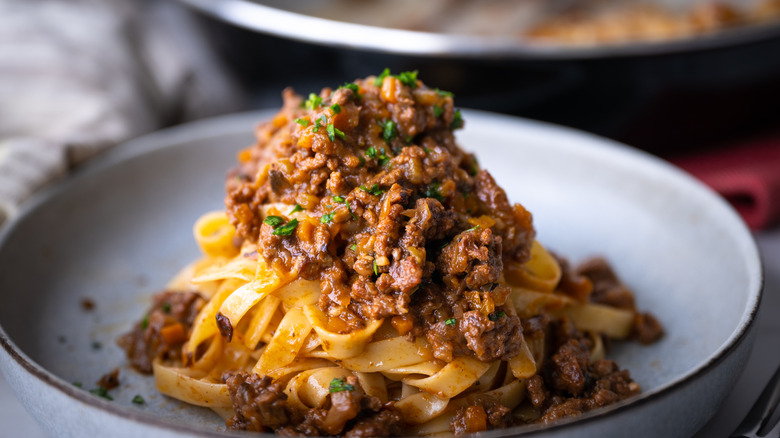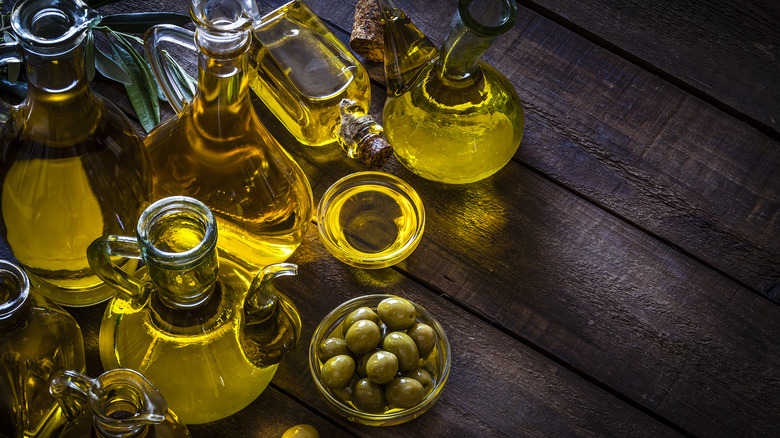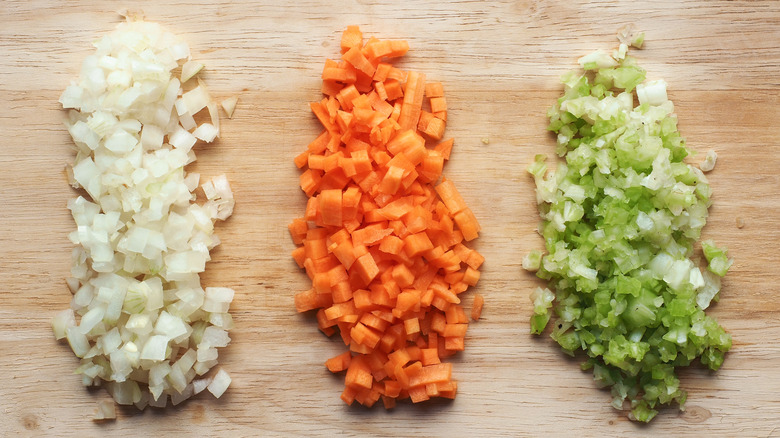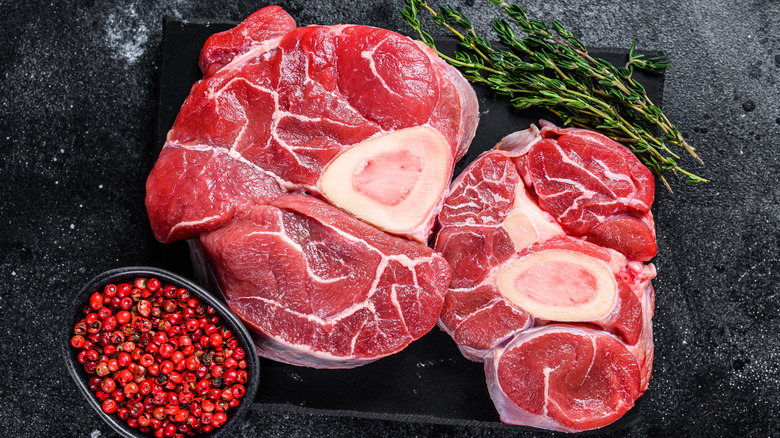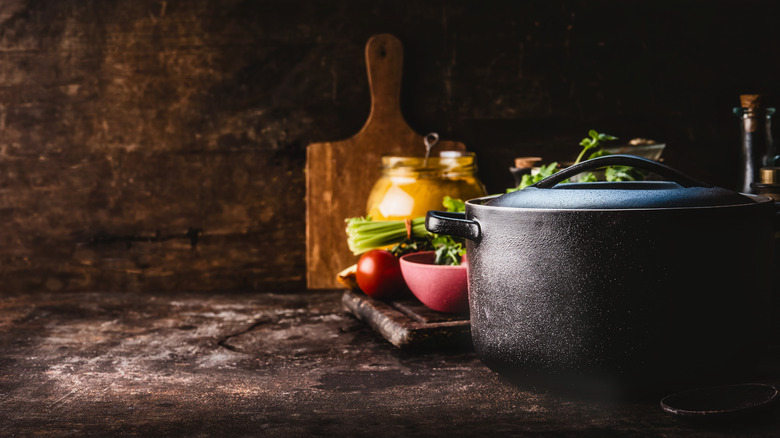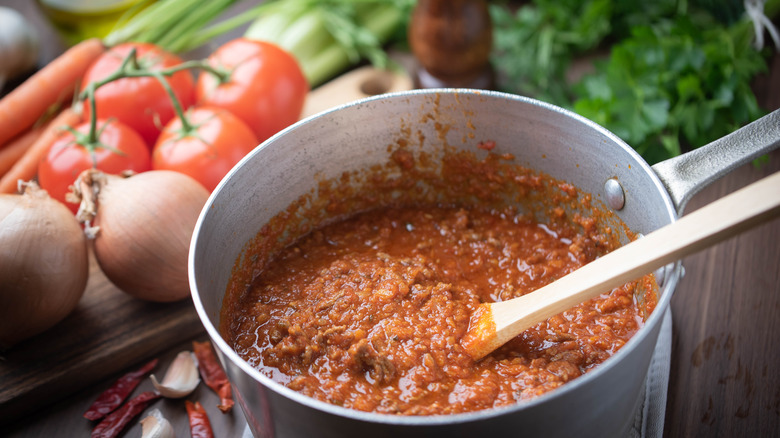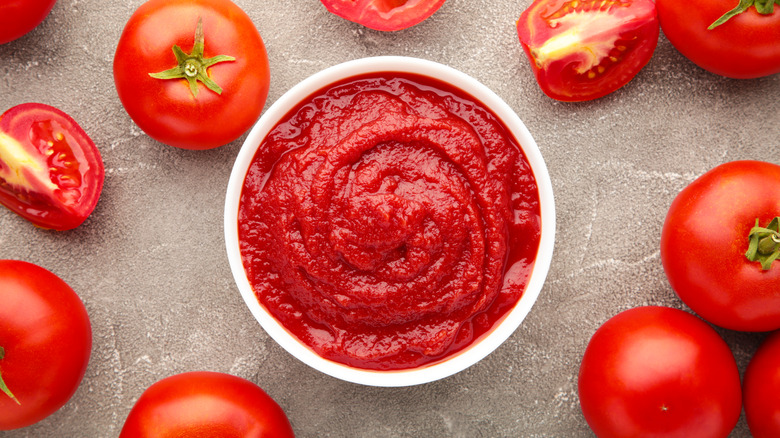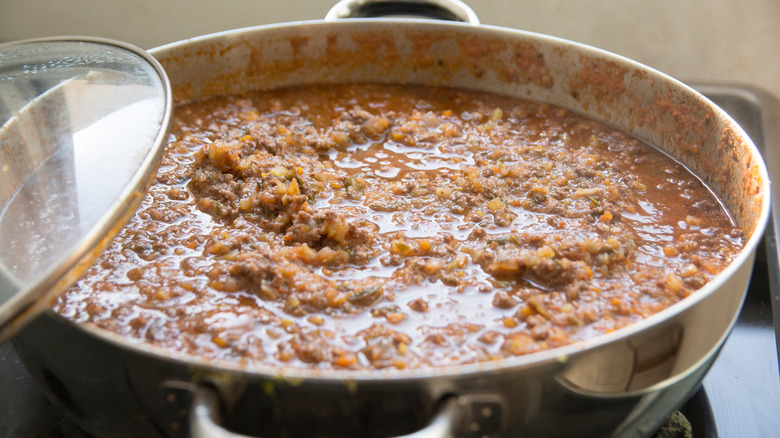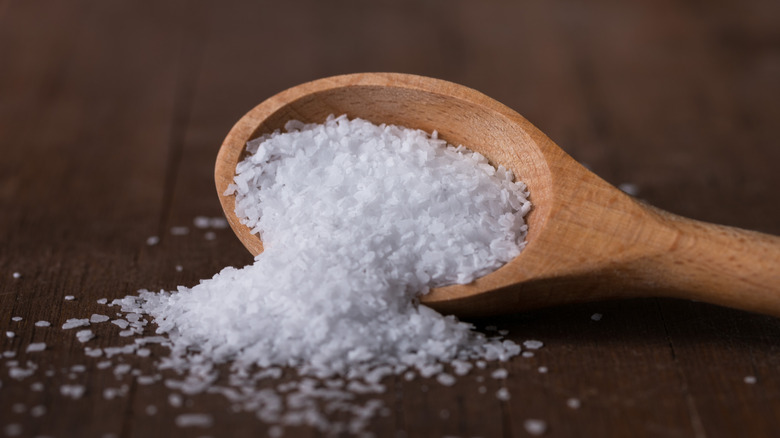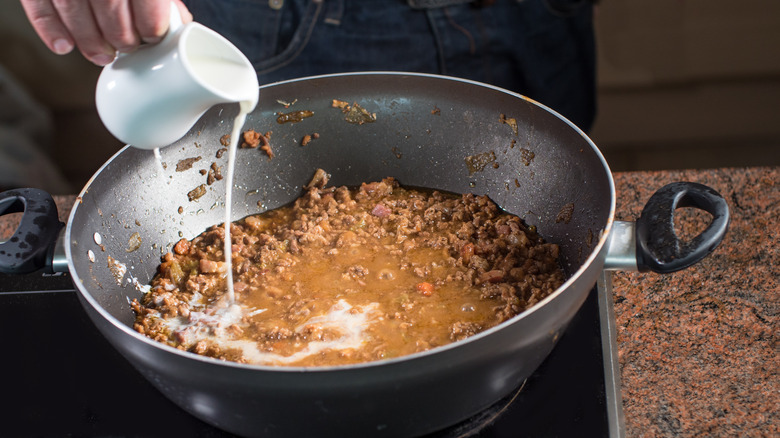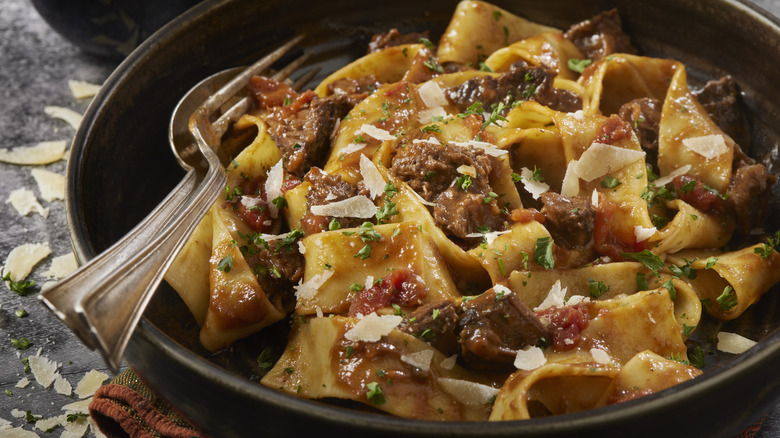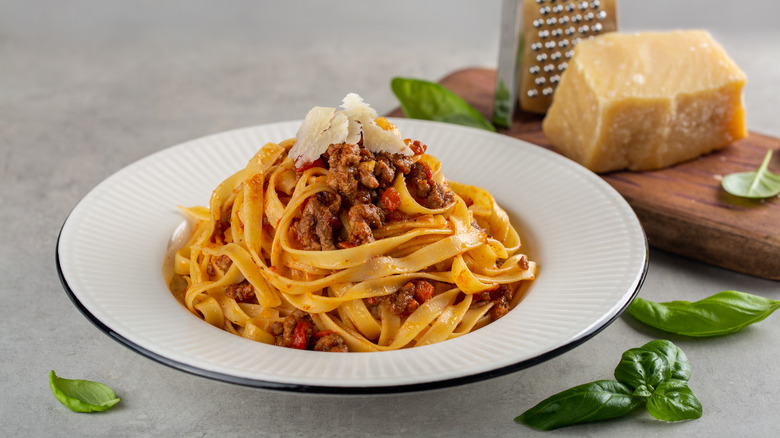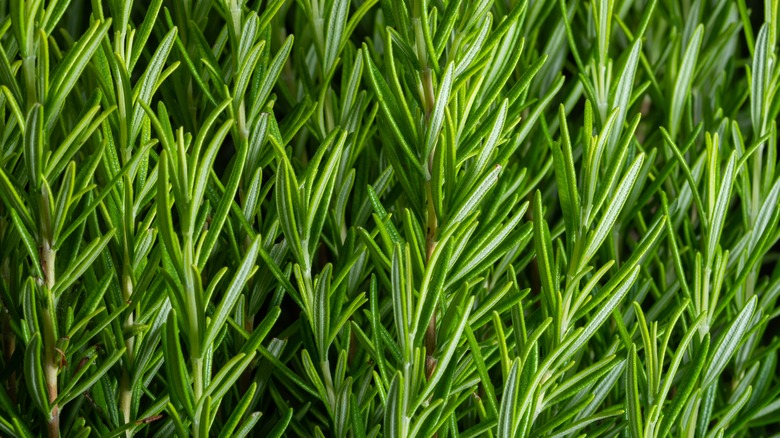15 Tips For Making The Perfect Ragu
Ragu is broadly defined as an Italian meat sauce, and it's most commonly associated with ragu alla bolognese, a classic pasta sauce made with ground meat and vegetable aromatics. The truth, though, is that ragu is much more than that.
Ragu is believed to have been first developed in Medieval France and gradually made its way to Italy, where it was adopted by the Neapolitans. Over time, the sauce developed into many different forms, including bolognese. But each region in Italy has its own version of ragu, many of them using their own combinations of meat and vegetables, and many of them, variations known as ragu bianco, or white ragu, avoid the use of tomatoes entirely.
Each ragu brings its own ingredients and cooking style to the table to deliver a unique, delicious sauce — but despite this, there are still a few key tips that apply to this dish that you can employ. And, if a classic ragu alla bolognese is your thing, there are also some techniques that you'll definitely want to get right. That's why we decided to put together our best pointers for making the perfect ragu.
1. For your fat, use olive oil
Ragu can be, and often is, made with fats like lard or butter, and it may be the case that traditional recipes favor using these over liquid oil. But unless you're following a classic recipe to the letter or you're trying to accentuate the creaminess or richness of your dish, you really can't go too wrong with olive oil. Olive oil is one of the cornerstones of Italian cuisine and has been produced in the country for thousands of years. Nowadays, the olive oil industry is embedded in almost every part of the country and, as such, finds its way into virtually every dish.
Olive oil works especially well in a ragu because while it does have a slightly herbal taste when raw when it's cooked, it gives the meat sauce a relatively neutral base to work from. It's subtle enough that it won't overpower the other flavors in the sauce — and remember, ragu is a food that's composed of some pretty rich flavors anyway, so it's unlikely you'll need the additional help, especially if you're using meat with high-fat content. While it is entirely possible to cook with extra virgin olive oil, you might want to use a less expensive brand to do so and leave the good stuff for things like salad dressings, where you want the flavor to really shine through.
2. Master your soffritto
A soffritto is a key element in many ragus, including ragu alla bolognese. Soffritto, which translates to fried slowly, is a combination of finely chopped celery, carrot, and onion, which is fried at the very start of a recipe. This combo of ingredients has an incredibly long history and has passed through many different cuisines. "Historically, [soffritto] originated in 1324 in a Catalan cookbook called "Libre de Sent Sovi," says chef and community educator Yadira Garcia on Loisa. "[Soffritto] comes from the word sofregit, which translates from Catalan as lightly fried or sautéed."
Over time, soffrito passed from its Catalan roots to become a staple in Italian food culture. The soffritto works as a base upon which all the other flavors are built and provides ragu with both a sweetness and a savoriness. To make a good soffritto, your ratios are highly important. You'll need two parts onion to one part each of carrot and celery. It's vital that the vegetables in your soffritto are chopped into uniform, small pieces. Above all, it's important that you cook your soffritto slowly — remember, the clue's in the name. You want to sweat and gently soften the vegetables, not brown them too excessively.
3. Use the right cut of meat
Different ragu recipes will call for different types of meat, from Abruzzo ragu, which uses mutton, to Latium ragu, which may include lamb. Generally, though, the most widely-known ragus will use either beef or a combination of beef and pork, with veal occasionally used too. If you're making a slow-cooked beef ragu, you'll want to make sure you use an appropriate cut of meat that's not too expensive, like shin or chuck. Shin is an excellent option as it's made up of a lot of lean connective tissue, and when cooked low and slow, this softens considerably and becomes tender and luscious. Chuck is similarly constructed and also has a good amount of fat, which again softens when the meat is cooked slowly.
A ragu alla bolognese is slightly different, and while getting a good cut is still vital, getting the right ratio of your different meats is arguably more important. You generally need a 2:1 ratio of beef to pork. The pork will bring a sweetness and cut through the deep, meaty flavors of the beef. Your beef should generally be ground pretty fine, and while you can also use a pack of ground pork, you might want to opt for small cubes of pancetta, which will give the ragu even more of an intense flavor. Ground pork loin or neck can also be used.
4. Use the right cookware
No matter what type of ragu you're making, you'll need the right cookware. And it all starts with your pot. Heavy-bottomed, cast-iron pans are the undisputed champions of ragu making. These pots generally hold and distribute heat really well, removing the risk of any cold spots or any scorching or burning. They also tend to be pretty resistant to food sticking to the bottom, provided that you're using enough oil.
It's helpful to get a pot that has a lid so that you can cover it while it simmers away for hours on end. However, if you don't have a cast-iron pan, any large pot will do the trick. One type to steer clear of, though, is lightweight aluminum, especially if you're using tomatoes in your sauce. This material tends to react pretty poorly when it comes into contact with acidic foods like tomatoes, and in the worst-case scenario, can end up releasing a metallic flavor into your food, making it taste bitter.
Aside from having the right pan, make sure you have a sharp enough knife to make sure your soffritto ingredients and your aromatics are chopped really finely. It can also be helpful to use a food processor if you're not in the mood for endless chopping. And make sure that you have a good-sized ladle to spoon all of that delicious ragu onto your pasta once it's cooked.
5. Your wine selection is as important as your meat
Many ragu sauces use wine in their recipes to underline and bolster the flavors of the dish. But usually, these recipes will be pretty sparing on the details of exactly what wine is best. And while you may know whether you need to use red or white, it's helpful to be more specific than that. If you're making a ragu bianco, which can include white wine in its recipe, it's best to go for a dry white, like pinot grigio or sauvignon blanc. Both of these have a relatively subtle flavor that isn't too acidic or sweet and won't flavor your sauce excessively.
For ragus that call for red wine, though, a little boldness can go a long way, and light-bodied wines should be avoided. "If cooking with reds, I avoid Pinot Noir. It is too elegant for the heat of a pan," says chef Raymond Blanc to Decanter. "Instead I reach for something inexpensive, big, spicy and rich." A Merlot, Grenache, Syrah, or a medium-bodied Italian red can work well. Make sure to avoid anything too heavy, as this can make your sauce taste bitter. More than anything, though, you should remember the most important rule: Use a wine that you'd be happy to drink. Its taste won't magically get better just because you're adding it to food.
6. Don't rush
Getting the best ingredients you can for your ragu is crucial. But the most important ingredient, and the one you need the most, is time. "A gentle, long, slow simmering — so it barely blips on the stove — has always been regarded as an essential ingredient of a good ragu," says the author of "The Missing Ingredient: The Curious Role of Time in Food and Flavor" Jenny Linford to The Washington Post. As the ragu simmers slowly, for several hours or more, all of the disparate elements in the pot meld together, with the meat and vegetables breaking down and amalgamating to become a seamless, complex sauce.
Slow cooking also causes the food molecules in the ingredients to develop in new ways, creating new layers of flavor that you just wouldn't be able to replicate without the time required. So, if you're tempted to cut down on the time required in a recipe or use a new-fangled kitchen gadget, drop that idea now. "No shortcuts are accepted, Instant Pot or otherwise," warns Corriere della Sera food editor Angela Frenda. Give your ragu time, and you'll be rewarded with a knockout sauce.
7. Choose your tomato products carefully
While we tend to associate the word ragu with a deep-red, tomato-rich sauce, it's notable that a lot of ragus don't contain tomatoes at all. Furthermore, some of the most famous ragus out there, like ragu alla bolognese, tend not to use canned tomatoes in many of their recipes, instead opting for tomato purée or tomato paste. If your recipe calls for purée, it's important to try and use it where possible. These products remove all of the skins and seeds of the tomatoes themselves, leaving you with a far smoother end result, which will stop your ragu from becoming too chunky.
Try and find the best tomato purée and tomato paste possible — even a simple ingredient like this can vary significantly in quality and flavor. If you can, try and find purée made from San Marzano tomatoes. This Italian variety is stringently regulated to ensure the best quality product, and the tomatoes are rich, sweet, and not overly tart. If you can't find any San Marzano tomato purée, you can always make your own. Just pass your tomatoes through a food mill, removing any skin, pulp, or seeds as you do so.
8. Remember to layer your flavors
The secret to a good ragu is building your flavors on top of each other, and doing that takes time. The flavor is built into layers when each component of the dish is added separately and cooked with attention and care. By doing this, you allow that ingredient to develop its own flavor depth, which then contributes to the overall quality of the ragu.
A good example of this in ragu is starting with your soffritto and allowing it to sweat and cook before you add your meat. If you were to just throw in everything at once, your soffritto, and all your other ingredients, would boil. By frying your soffritto, though, you develop additional flavor compounds, with your vegetables becoming softer, sweeter, and starting to caramelize. Cooking your meat before adding your liquid, too, will give it an opportunity to brown as the Maillard reaction occurs.
Layering flavors happens up until the very end, with certain foods tasting better if they're cooked less. Dairy is a good example of this in ragu — the milk and cheese are usually added at the end, with the latter providing a punchy contrast to the rich sauce. Adding cheese on top, instead of stirring it in, also makes it look better and layers on texture as well as flavor.
9. Be careful with the salt you use
When it comes to ragu, not all salt will have the same effect. The type of salt you use can significantly alter the flavor of a ragu, thanks to the differences in crystal size, according to research published in the Journal of Texture Studies. If you use a finer salt grain, it will dissolve quicker in your ragu; therefore, it tends to produce a sharper, saltier taste. Large grains, conversely, take longer to dissolve and spread their flavor, and so they usually taste milder.
For ragu, it's usually best to use a middle-sized grain like kosher salt. Kosher salt disperses flavor more slowly, and it works particularly well with meats, boosting their taste without making them briny. With kosher salt, it's also far easier to control the level of salt. Because the salt grains are larger, it's easier to add just a little bit at a time. With table salt, it's all too easy to add too big of a pinch and end up tipping the balance of your sauce, so it's too salty. Remember, however, that when making ragu, you may be working with ingredients that are already quite salty, like pancetta. Therefore, hold off on salting the dish until everything's well-cooked and the pancetta has had a chance to disperse flavor. You can then taste it to see how much it needs.
10. Use a pinch of sugar
Although ragu is a deeply savory sauce, it still needs some sweetness to get it there. In a primarily savory dish, sugar acts as both a flavor booster and can improve its texture. On a flavor level, sugar helps to balance out sour, bitter notes and can gently amplify other tastes, which contribute to the savoriness of a meal. This could be because of the fact that both sweet and umami receptors in our tastebuds share space, which could lead to a boost when you combine the two.
That's useful for pretty much any ragu you're making, but sugar is particularly useful if you're using tomatoes in your recipe. "Plenty of tomatoes are really quite acidic, so will only benefit from a bit of added sugar," says "An A-Z Of Pasta" author Rachel Roddy to The Guardian. Tomatoes have an approximate pH value of 4.5 – for context, the pH value of pickles falls between 3.5-3.9, so that's pretty sour. Adding wine to a ragu can also raise its acidity level — but a pinch of sugar will stop your sauce from developing too much astringency. Make sure you taste your ragu after adding sugar, though, and only put in a little at a time; otherwise, you may end up making a sweet sauce.
11. Milk can help, but it's not essential
To add milk, or not to add milk: It's the eternal question when it comes to ragu. The answer, thankfully, is a little more flexible than you might think. Some ragu experts swear by adding milk to ragu alla bolognese specifically. It's argued that adding milk towards the end of the cooking process gives your sauce a smoother, creamier consistency, can make the meat softer and more tender, and also helps to temper any particularly acidic flavors.
However, while it's nice to add, it's really not essential. "Milk adds a little richness and it may aid in tenderizing meat but if you're using quality meat, then you don't need it. The quality of the meat you choose will always show," says chef Guy Grossi in the Sydney Morning Herald. Additionally, Accademia Italiana Della Cucina, the leading authority on ragu alla bolognese preparation, points out that milk can be added to the sauce, but it's optional.
Our advice, therefore, is to go for the best meat you can afford, cook the sauce low and slow, and only add milk if you think your sauce will really benefit. If you are going to add milk to your ragu, however, make sure you use whole milk. The higher dairy fat content gives it that creaminess that you want, which low-fat milk just can't replicate.
12. Complement your ragu with the right pasta
The joy of making ragu is, surely, the fact that when it's finished, you get to heap it on top of piles of pasta and chow down. But which pasta is the best? While you can technically use any pasta you like, heftier shapes are best to be able to carry the thick sauce effectively. If using a long pasta, try and find a wider cut, like pappardelle or tagliatelle. These give you more surface area for the meat sauce to cling onto. Fettuccine and spaghetti are also good choices, but as they're thinner, you may find it harder to get the sauce-to-pasta ratio just right.
Short-cut kinds of pasta also work fantastically with ragu, with paccheri, rigatoni, and penne all great choices. These tubular kinds of pasta are great at trapping sauce inside them, making every bite juicy and flavorful. As rigatoni and penne are usually ridged, and you can find ridged paccheri too, they're excellent at collecting the sauce on their outer edges for maximum taste. Conchiglie can also be a good choice, as the shell shape works as a vehicle for the sauce. It might be best to steer clear of especially small shapes like orzo or pastini, as they have a tendency to get lost in the sauce.
13. The cheese you use matters
While you can technically have a bowl of ragu without cheese, in most situations, adding a sprinkling before eating only makes it better. The cheese you choose, though, is important. Parmesan or Parmigiano-Reggiano are by far the best options. These cheeses are similar but differ in the amount of time they're aged and manufacturing processes, with Parmigiano-Reggiano being aged for longer and its production tightly controlled. Both kinds of cheese are hard and have a complex, nutty flavor, with Parmigiano-Reggiano generally being more of a punch to it, thanks to its longer aging process. Both of them pair excellently with the meaty flavors of ragu and have a sharpness that works against the meat very well.
Pecorino cheese can also be used on top of ragu, as can Grana Padano. Both are hard, easily grateable cheeses with strong flavors. Pecorino tends to be sharper, whereas Grana Padano can be somewhat sweeter. Generally, you should always grate your cheese on top of your ragu once it's already served, allowing the heat of the sauce to soften it while you start eating. If you want to impart more flavor to your ragu, though, you can add Parmigiano-Reggiano or parmesan rinds directly into the sauce as it cooks.
14. Be careful with your variations
Ragu is a dish with many different recipes, and it can be made with countless different ingredients and meat combinations. Crucially, though, a lot of these different recipes have been developed in accordance with tradition, locally available produce, and the cooking styles of the regions that create them. As such, it's important not to go overboard and freestyle with variations from your recipe. You might make something good by doing so, but it won't be a classic ragu.
The standard recipe for ragu alla bolognese, published by the Accademia Italiana della Cucina, illustrates this well. It points out that smoked bacon should never be used in place of pork belly — this will make your bolognese taste too, well, smoky and give it flavor notes that don't belong in ragu. It also highlights that herbs or aromatics like garlic shouldn't be used in this specific ragu style.
Flour should also never be used in a ragu alla bolognese. While it can thicken a sauce, this really isn't necessary, as cooking it for long enough will make it thicker while intensifying its flavor. If you're resorting to using flour, you're probably just thickening a weak-tasting sauce, and your ragu will lack punch.
15. Your aromatics will change the style of your ragu
Most people are used to reaching for a bulb of garlic when they start preparing their meal. But when it comes to ragu, adding it might change your dish entirely. Ragu alla bolognese, for example, should never contain garlic or any additional herbs like parsley or rosemary. In the Bolognan style, the main flavor notes come from the meat, wine, soffritto, and, if using it, the milk added at the end. Any other aromatics are a distraction.
A Tuscan ragu, on the other hand, amps up the aromatics and uses a good amount of garlic and rosemary. The latter gives the ragu a slightly floral, woody flavor, with the garlic creating pungency. Ragu made in Basilicata may use parsley to give the sauce a herbal lift, whereas, in Friuli, traditional ragu uses aromatics in abundance, throwing in juniper, bay leaves, cloves, and even horseradish for an extra kick. As these recipes have been road-tested for generations, don't be scared of them. It can be pretty exciting to try a ragu with completely different aromatics to create something potentially unusual yet still delicious.
